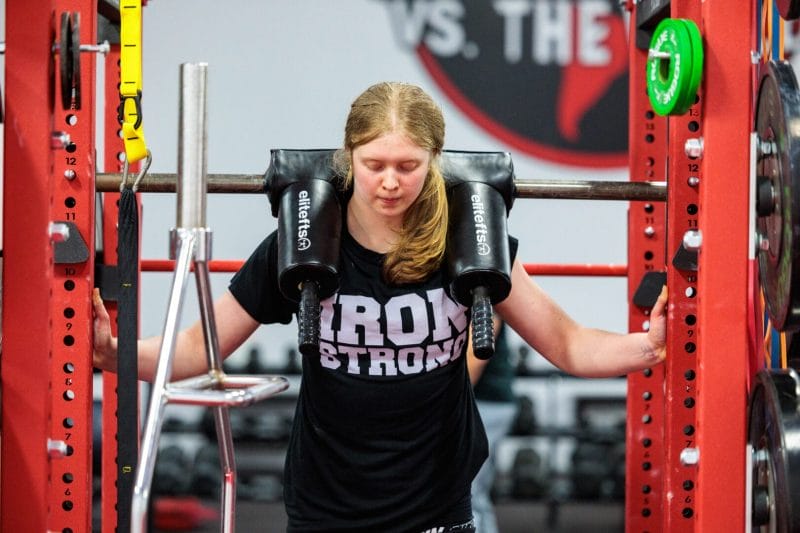If you’re like me, you probably have a slight obsession with structure and systems. I tend to always look for creative ways to design our programs and implement them with some method for controlling flow, time and efficiency. This is particularly important when it comes to our teams throughout the season. At Iron Performance Center, we may see multiple groups, teams and one-on-one athletes all coming through at the same time; it can be chaotic should some form of structure be neglected.
It’s finding ways to manage the chaos. Teams may be coming from practice, heading to practice after or have other scheduled initiatives that require workouts to be completed in a timely fashion. They may have sudden scrimmages come up last minute or change up the practice schedule that further cuts into training time. As such, we need to be adaptable yet effective. It’s a fine balance between trying to create a structured plan with some form of time management while also respecting the principles of training qualities as it pertains to volume, load, intent and rest.
One system we may like to use involves putting a series of exercises (with appropriate volume and intensities) together with a set time limit to complete each exercise. Essentially, you would set minute timelines to complete the prescription before moving on to the next exercise. Whatever time remains before the following minute would be considered the “rest” time. We call these timed complexes.
What we like about timed complexes is the flexibility. You can modify the complex based on time, training quality, group size or any combination of the three. It keeps athletes accountable to the clock and to each other as their teammates will be “on deck” ready to start their next exercise.
We typically break our complexes up based on training quality and then modify the number of exercises (both main and accessory selections) to accommodate how large the group sizes are. From there, we’ll select the time range we feel appropriate for the complex goal. We’ll review some examples of common timed complexes below.
Power Complexes
These complexes will typically include jumps, throws and sprints. Should we decide to contrast pair the complex, we may implement loaded patterns to better potentiate our athletes. Understand that you can choose to keep the explosive exercise in isolation should you deem fit.
Timed power complexes could also be great if looking to implement a french contrast series while on the clock. You could also adjust the set time for the complex or add/remove exercises based on group size or needed rest time. We’ve typically found it useful to have the 4th exercise be something less stressful in order to have athletes prepared to hammer the main explosive movement.
The examples below cover a variety of power complexes we may do with our athletes. They include lower, upper and total body series that can be made with 3-4 exercises per series depending on the group size. We’ve found that the short but intense nature of these power complexes are great for game day lifts with our team sports. The exercises may only take 8-12 seconds to complete allowing an average of 50 seconds of rest; a great 1:5 WR ratio for dynamic effort work.

Strength Complexes
Similar to our power complexes, we can categorize them into lower, upper or total body blocks. While emphasis will be on “raising the ceiling” with high force output, we’ll usually supplement the strength complex with lower intensity prescriptions in order to get some accumulation work in. Prescriptions will be higher in complexity and may have a higher impact on tissues.
We typically do total body strength complexes with our team sport athletes. When organizing the complex to accommodate larger groups, we have to ensure we set enough time aside to complete the volumes needed while also considering the demand of accessory fillers. We want to ensure we don’t have athletes too fatigued in a similar plane movement as their main strength exercise.
On average, strength exercises may take 15-20 seconds to complete with accessories taking approximately 20-25 seconds with rest being 40 seconds; a 1:3 WR ratio. This allows almost 2 minutes of rest time before the next set’s strength exercise. Assuming the accessories don’t accumulate systemic fatigue, our athletes are usually rested enough for another full effort when the time comes.
The examples below include lower, upper and total body strength complexes that we may use in season. While they may be a staple during the work week, we may also sprinkle them in a couple days before a game. We’d simply lower the reps to ensure greater rest time during the complex.

Accumulation Complexes
These might be considered your typical metabolic or “work day” complexes. While we may still categorize them as upper, lower or total body, we typically keep these complexes as total body. Exercise prescriptions are catered to be lower in complexity and lower impact on the joints. The whole point is selecting exercises and schemes that “pull the floor”.
Accumulation complexes may be seen more commonly during off season or (should we feel appropriate) done early in the week during the season. We may simply lower the total number of sets to account for volume. Average exercise completion time may range from 25-35 seconds with rest time being an average of 30 seconds. This 1:1 WR ratio means fatigue levels will be a lot higher.
The examples below can review both upper/lower splits and total body series. With accumulation complexes, we find ourselves implementing even more unilateral work. Keep in mind that it’ll take double the time to complete so make sure the reps are appropriate for the timing.

Other Considerations
There is a ton of variety when deciding to implement timed complexes. While tempting to toss a little bit of everything in the plan, we need to consider the practicality of implementation. With timed complexes, we’re limited by the clock and the accumulated fatigue that may impact output of certain exercises. If neglected, we won’t get the desired adaptations.
The use of tempos can be a great tool for building certain training qualities while also managing load. Should you choose to implement them, consider the total time needed to complete reps for each exercise. If sticking with tied complexes, tempos can eat away at remaining rest time and impact future exercise outputs. Either make the reps low or make sure proceeding exercises won’t accumulate much fatigue.
When planning out your timed complexes, consider the tools needed for each exercise. If working in larger groups, having available equipment that won’t lead to cross over or impact flow of the room will ensure athletes don’t get “bunched up”. We’ve seen it happen sometimes where athletes are waiting for equipment and this bleeds into their next exercise time. For more on weight room flow tips, you can read my article here.
In Closing
Timed complexes are a great tool for keeping athletes accountable and driving high outputs towards a desired adaptation. Through all the chaos that follows team sports throughout the season, timed complexes are a simple way to manage the time you do have while still deriving focused work towards training goals. If nothing else, we’ve found our athletes like them and it keeps the energy in the room high and competitive.
You’re on the clock. Get going! Need help taking your game to the next level? We have your back. Click here to schedule a call with our staff and we’ll get to work!


